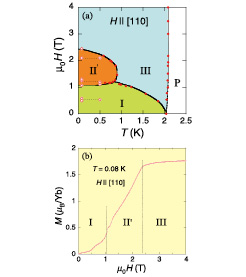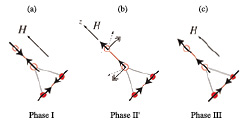Hidden Multipole Order in Yb2Pt2Pb with the Orthogonal Dimer Structure
Sakakibara Group
When a Yb3+ ion (4f13) is situated in a crystalline electric field of low symmetry, a Kramers doublet becomes the ground state of the J=7/2 multiplet. Magnetic properties of such systems can be usually described in terms of a magnetic dipole moment carried by the Kramers doublet. Here we show that the tetragonal compound Yb2Pt2Pb, which orders antiferromagnetically at TN=2.1 K [1], exhibits a very unusual ordered state in a magnetic field, whose order parameter is likely to be a high-rank magnetic multipole moment [2].

Fig. 1. (a) Magnetic phase diagram of Yb2Pt2Pb for H || [110]. (b) Field variation of the magnetization of Yb2Pt2Pb for H || [110] measured at 80 mK.

Fig. 2. Proposed magnetic structures of Yb2Pt2Pb for H || [110]. (a) Phase I. Each Yb sublattice has a collinear structure. Thick arrows indicate the Yb magnetic moment. (b) Phase II’. Sublattice B (solid circles) remains in a collinear state, whereas sublattice A (open circles) exhibits a pseudo-spin flop. Dashed arrows denote the pseudo spins whereas double arrows indicate the multipole moments. (c) Phase III. Sublattice B remains in a collinear state, whereas sublattice A becomes parmagnetic.
The Yb lattice in Yb2Pt2Pb can be viewed as being composed of orthogonal dimers aligned along [110] or [1-10] directions [1]; we can define two sublattices of Yb ions: sublattice A of [110] dimers and sublattice B of [1-10] dimers. In the preceding experiment, Ochiai et al. [3] have shown that the Yb moment has a strong Ising anisotropy along the dimer axis. When a magnetic field H is applied parallel to [110], the antiferromagnetic moments on the sublattice B are decoupled from H because their Ising axes are perpendicular to H. Accordingly, only the moments on sublattice A respond to H and the phase diagram is given in Fig. 1a, where three different ordered phases I, II’ and III exist. The magnetic structures of phases I and III are shown in Figs. 2a and 2c, respectively. In phase I, both sublattices A and B are essentially in a collinear structure. In phase III, magnetic moments on sublattice B remain in a collinear structure but those on sublattice A become paramagnetic. Ochiai et al. [3] pointed out that the highly anisotropic magnetic properties can be understood by assuming the ground state doublet of Yb3+ ion to be predominantly composed of states ⎮±7/2〉 with the local quantization axis parallel to either [110] or [1-10].
There is another phase, phase II’, in the phase diagram [3]. The exact nature of phase II’, however, has not been clear in the preceding experiments. We have examined the low temperature magnetization of Yb2Pt2Pb and found that the Yb magnetic moment increases almost linearly in phase II’ and saturates without discontinuity; quite unexpectedly, the II’-III transition is of second order. This behavior of phase II’ is apparently incompatible with the Ising anisotropy of the Yb moment. We propose that a high-rank magnetic multipole moment is the order parameter in phase II’. For simplicity, let us assume the wave functions of the Kramers doublet to be ⎮±7/2〉. In a pseudo-spin representation, the z component is the magnetic dipole Jz. On the other hand, the x and y components are rank-7 magnetic multipoles (octacosahectapoles). It can then be shown that a pseudo-spin flop occurs in a magnetic field along the Ising axis, if an interaction between the multipole moments is sufficiently strong (Fig.2 b) [2]. In this situation, the magnetic moment along [110] linearly increases with H and continuously saturates, as observed by experiment.
References
- [1] M. S. Kim, M. C. Bennett, and M. C. Aronson, Phys. Rev. B 77, 144425 (2008).
- [2] Y. Shimura, T. Sakakibara, K. Iwasawa, K. Sugiyama, and Y. Onuki, J. Phys. Soc. Jpn. 81, 103601 (2012).
- [3] A. Ochiai, S. Matsuda, Y. Ikeda, Y. Shimizu, S. Toyoshima, H. Aoki, and K. Katoh, J. Phys. Soc. Jpn. 80, 123705 (2011).
